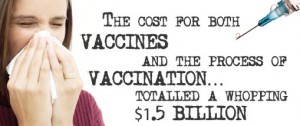Sifting Through The Swine Flu Hysteria
Wait! I’ve seen this piggy before!
One of the main reasons for the mass hysteria that was induced by the WHO, the media, health agencies and the governments was that it was primarily affecting the young and otherwise hale. With seasonal influenza, those that became infected were always the very young, the elderly, and those already suffering from another sickness. H1N1 became very worrisome once the data came in showing that the average age of deaths was 37 years old, compared to 75 years for the seasonal flu.
However, after the flurry of panic, it appears that there’s a very good reason for the young and healthy to be more easily infected: the older generation has seen this type of strain before. H1N1 was widely touted as a “first” and “never-seen-never-before-encountered” influenza. This was very misleading, as H1N1 is not only related to a string of viruses from 1918 – 1956, but was also seen in an outbreak in the United States in 1976.
Back in 1976, there were clinical trials conducted that demonstrated that those born prior to 1956 were for the most part protected from the strain. Carrying this forward to the situation in 2009, most of the population over 50 years old are somewhat familiar with the H1N1 virus, providing them with more immunity against swine flu. For those younger than 50, their bodies have not yet experienced any exposure to H1N1, which is why this younger (and healthier) age group suffered more severely.
So why was this critical information never widely known or publicly provided by the media? It appears that it was simply glossed over; the high level of panic was simply maintained by the media, the WHO and the governments, and the general population never questioned it. Everyone was so busy trying to find masks and where they could possibly get Tamiflu or Relenza (the two main anti-influenza medications) before the H1N1 vaccine was available, that the masses never bothered to look for this information.
The WHO that cried wolf pig
Even today, after the swine flu pandemic was declared over, not many realize the extent to which the panic was unnecessary when looking at the numbers. Every year, the WHO estimates that seasonal influenza typically infects anywhere from three to five million people severely with a death count of some 250,000 to 500,000 deaths worldwide. To this date, H1N1 has killed approximately 18,000 people…around the world.
According to Health Canada, some 4,000 to 8,000 Canadians die each year from the seasonal flu from pneumonia or other related complications, as of January 28, 2010, the Public Health Agency of Canada reported 426 deaths from H1N1 – substantially less than the seasonal flu. In the United States, they see an average of 36,000 deaths from the seasonal flu annually, which are double the deaths that were seen for swine flu on a global scale.
[pullquote]It may be that in the future, when there is truly a pandemic, the public will be much more skeptical and ignore warnings from the governments or health agencies like the WHO.[/pullquote]
So why the WHO-induced panic? Speaking with Michael Fumento, journalist, author, attorney, researcher and analyst who has been writing about pandemics since AIDS in 1987, provides some further insight to the WHO that cried wolf, er, pig that is. Fumento has been on record from the very beginning, arguing that the WHO “had absolutely no reason to declare it a pandemic because it was clearly vastly milder than typical seasonal flu,” which is supported by the data.
The reason he provides for the WHO’s declaration of the swine flu as a pandemic is more of a self-fulfilling prophecy. The WHO has been asserting since 2005 that avian flu (H5N1) was a serious threat that could possibly evolve to become a pandemic. These assertions have come despite numerous studies that state avian flu is very far from taking that type of evolutionary step.
Fumento contends that when swine flu began to garner attention, the WHO simply said, “See! We were right! There was a pandemic on the horizon!” and the media lapped it up, and consequently, so too did the general public. Much like the children’s fable, the WHO had cried pandemic, and we as the villagers simply said “where?!”
What worsens the whole situation is that the governments and other health agencies were content to arm themselves against this threat of a supposed pandemic when really they should have known better. When the WHO elevated swine flu to pandemic status, governments began to order swine flu vaccine as well as Tamiflu and Relenza—anti-influenza medications that were provided to patients after they contracted H1N1—without questioning whether or not stockpiles were necessary.
Understandably, the WHO is an international organization that should be both accountable and transparent in their actions, but the key words there are ‘should be’. No matter if the WHO was acting out of their own political motivations as Fumento argues, or were simply being excessively cautious with a flu they were unfamiliar with, he asserts that if he knew that swine flu wasn’t a pandemic, so too should have the health officials and governments.
The data was available to everyone; it was a matter of looking past the hysteria of these deaths that the media and the WHO purported were popping up everywhere, anywhere, and constantly, and actually examining the hard facts. And the fact remains that had we done what Fumento did and went straight to the sources, “looked at the NUMBERS and not the pronouncements,” we would have known the truth: there was no pandemic on the scale the WHO and other health officials claimed where hundreds of thousands were at risk of dying.
































Share the post "Sifting Through The Swine Flu Hysteria"